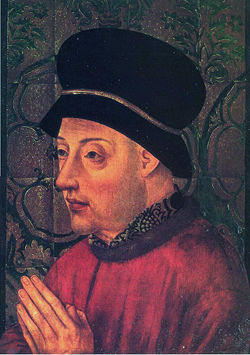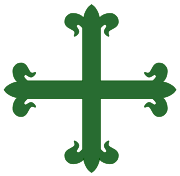John I of Portugal
| John I | |
|---|---|
| King of Portugal and the Algarve (more...) | |
 |
|
| Reign | April 6, 1385—August 14, 1433 |
| Predecessor | Beatrice (disputed) |
| Successor | Edward |
| Consort | Philippa of Lancaster |
| Issue | |
| Edward Infante Pedro, Duke of Coimbra Henry the Navigator Infanta Isabel, Duchess of Burgundy Infante João, Lord of Reguengos de Monsaraz Infante Ferdinand, the Saint Prince Afonso, 1st Duke of Braganza (natural son) Beatrice, Countess of Arundel (natural daughter) |
|
| Royal house | House of Aviz |
| Father | Peter I |
| Mother | Teresa Gille Lourenço |
| Born | April 11, 1357 Lisbon, Kingdom of Portugal |
| Died | August 13, 1433 (aged 76) Lisbon, Kingdom of Portugal |
| Burial | Chapel of the Founder, Monastery of Batalha, Batalha, District of Leiria, Portugal |
|
|||||||||||||||||||||||||||||||||||
John I (Portuguese: João, pronounced [ʒuˈɐ̃ũ]; Lisbon, 11 April 1357 – Lisbon, 14 August 1433), called the Good (sometimes the Great) or of Happy Memory, was the tenth King of Portugal and the Algarve and the first to use the title Lord of Ceuta. He was the natural son of Peter I by a noble Galician woman named Teresa Lourenço, daughter of Lourenço Martins, o da Praça, and wife Sancha Martins. In 1364 he was created Grand Master of the Order of Aviz. He became king in 1385, after the 1383–1385 Crisis.
On the death of his half-brother Ferdinand I in October 1383, without a male heir, strenuous efforts were made to secure the succession for princess Beatrice, Ferdinand's only daughter. As heiress-apparent, Beatrice had married king John I of Castile, but popular sentiment was against an arrangement in which Portugal would have become virtually united with Castile. The 1383–1385 Crisis followed, a period of political anarchy, when no monarch ruled the country.
On April 6 1385, the council of the kingdom (cortes in Portuguese) met in Coimbra and declared John, then Master of Aviz, king of Portugal. This was in effect a declaration of war against Castile and its claims to the Portuguese throne. Soon after, the king of Castile invaded Portugal, with the purpose of conquering Lisbon and removing John I from the throne. John I of Castile was accompanied by French allied cavalry while English troops and generals took the side of John (see Hundred Years War). John I then named Nuno Álvares Pereira, his loyal and talented supporter, general and protector of the Kingdom. The invasion was repelled during the summer after the Battle of Atoleiros and, especially, the decisive battle of Aljubarrota (August 14, 1385), where the Castilian army was virtually annihilated. John I of Castile then retreated and the stability of John I's throne was permanently secured.
On 11 February, 1387, John I married Philippa of Lancaster, daughter of John of Gaunt, who had proved to be a worthy ally, consolidating the Anglo-Portuguese Alliance that endures to the present day.
After the death of John I of Castile in 1390, without leaving issue by Beatrice, John I of Portugal ruled in peace and pursued the economic development of the country. The only significant military action was the siege and conquest of the city of Ceuta in 1415. By this step he aimed to control navigation of the African coast. But in longer perspective, this was the first step opening the Arabian world to medieval Europe, which in fact led to the Age of Discovery with Portuguese explorers sailing across the whole world. It should be noted that the global Muslim population had climbed to about 8 per cent as against the Christian population of 14 per cent by 1400.
Contemporaneous writers describe him as a man of wit, very keen on concentrating the power on himself, but at the same time with a benevolent and kind personality. His youthful education as master of a religious order made him an unusually learned king for the Middle Ages. His love for knowledge and culture was passed to his sons: Duarte, the future king, was a poet and a writer, Pedro, the duke of Coimbra, was one of the most learned princes of his time and Prince Henry the Navigator, the duke of Viseu, started a school of navigation and invested heavily in science and development of nautical topics. In 1430, his only surviving daughter, Isabella, married Philip the Good, Duke of Burgundy and enjoyed an extremely refined court in his lands; she was the mother of Charles the Bold.
Contents |
Genealogical data
Ancestors
| John I of Portugal | Father: Pedro I of Portugal |
Father's father: Afonso IV of Portugal |
Father's father's father: Denis of Portugal |
| Father's father's mother: Elizabeth of Aragon |
|||
| Father's mother: Beatrice of Castile |
Father's mother's father: Sancho IV of Castile |
||
| Father's mother's mother: María de Molina |
|||
| Mother: Teresa Lourenço |
Mother's father: Lourenço Martins |
Mother's father's father: Unknown |
|
| Mother's father's mother: Unknown |
|||
| Mother's mother: Sancha Martins |
Mother's mother's father: Unknown |
||
| Mother's mother's mother: Unknown |
Marriages and descendants
John I married at Oporto on February 2 1387 Philippa of Lancaster, daughter of John of Gaunt, 1st Duke of Lancaster and Blanche of Lancaster. From that marriage were born several famous princes and princesses of Portugal (Infantes) that became known as the Illustrious Generation (Portuguese: Ínclita Geração).
| Name | Birth | Death | Notes |
|---|---|---|---|
| By Philippa of Lancaster (1359–July 19 1415; married on February 2 1387) | |||
| Infanta Branca | July 30 1388 | March 6 1389 | |
| Infante Afonso | July 30 1390 | December 22 1400 | |
| Infante Duarte | October 31 1391 | September 13 1438 | Who succeeded him as Duarte I, 11th King of Portugal. |
| Infante Pedro | December 9 1392 | May 20 1449 | Duke of Coimbra. Died in the Battle of Alfarrobeira. |
| Infante Henrique | December 4 1394 | November 13 1460 | Known as Henry the Navigator. Duke of Viseu and Grand-Master of the Order of Christ. |
| Infanta Isabel | February 11 1397 | December 11 1471 | Duchess Consort of Burgundy by marriage to Philip III, Duke of Burgundy. |
| Infanta Branca | April 11 1398 | July 27 1398 | |
| Infante João | January 13 1400 | October 18 1442 | Constable of the Kingdom and grandfather of Isabella of Castile. |
| Infante Fernando | September 29 1402 | June 5 1443 | Grand Master of the Order of Aviz. Died in captivity in Fes, Morocco. |
| By Inês Peres Esteves (c. 1350–1400?) | |||
| Afonso | August 10 1377 | December 15 1461 | Natural son and 1st Duke of Braganza. |
| Branca | 1378 | 1379 | Natural daughter. |
| Beatriz | c. 1382 | October 25 1439 | Natural daughter. Countess Consort of Arundel by marriage to Thomas Fitzalan, 12th Earl of Arundel. Countess Consort of Huntingdon by marriage to John Holland, 2nd Earl of Huntingdon, later Duke of Exeter. |
|
John I of Portugal
House of Aviz
Cadet branch of the House of Burgundy
Born: 11 April 1357 Died: 14 August 1433 |
||
| Regnal titles | ||
|---|---|---|
| Vacant
1383-1385 crisis
Title last held by
Ferdinand IDisputed claim by Beatrice |
King of Portugal and the Algarves 1385 – 1433 |
Succeeded by Edward |
|
||||||||||||||||||||
|
||||||||||||||
This article incorporates text from the Encyclopædia Britannica Eleventh Edition, a publication now in the public domain.
Sources:
Williamson, D. 1988. ‘’Debrett’s Kings and Queens of Europe’’
